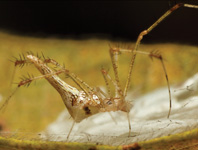Abstract
A characteristic new species Meotipa sahyadri n. sp. with tall and white translucent abdomen in females is described in detail based on morphology of both sexes, based on specimens collected from the Western Ghats of Maharashtra, Gujarat and Goa. The new species has epigynal projection which is known only in Meotipa picturata Simon, 1895, but differs in shape (trifid vs. quadrangular respectively). Males have longest straight embolus exceeding conductor length. Observations of its natural history are provided. Meotipa picturata is newly recorded from Goa, which extends its north-westward distribution from the previously known records from ‘Kodei Kanal’, India (type locality), Ratchasima Province, Thailand and East Kalimantan, Indonesia. A new combination Meotipa andamanensis (Tikader, 1977) n. comb. (=Argyrodes andamanensis) is proposed based on the comparison of description and illustrations provided in the original paper to that of the characters of the type species M.picturata. 242 morphological characters studied in the previous literature and one additional character ‘epigynal projection’ were scored for Meotipa sahyadri n. sp. and Meotipa picturata. These species were obtained monophyletic, placed within Theridiinae as sister to Chrysso cf. nigriceps using parsimony analysis and Bayesian inference.
References
Agnarsson, I. (2004) Morphological phylogeny of cobweb spiders and their relatives (Araneae, Araneoidea, Theridiidae). Zoological Journal of the Linnean Society, 141, 447–626.
https://doi.org/10.1111/j.1096-3642.2004.00120.xÁlvarez-Padilla, F. & Hormiga, G. (2008) A protocol for digesting internal soft tissues and mounting spiders for scanning electron microscopy. Journal of Arachnology, 35, 538–542.
https://doi.org/10.1636/Sh06-55.1Arnedo, M., Agnarsson, I. & Gillespie, R. (2007) Molecular insights into the phylogenetic structure of the spider genus Theridion (Araneae, Theridiidae) and the origin of the Hawaiian Theridion-like fauna. Zoologica Scripta, 36, 337–352.
https://doi.org/10.1111/j.1463-6409.2007.00280.xDeeleman-Reinhold, C.L. (2009) Spiny theridiids in the Asian tropics. Systematics, notes on behaviour and species richness (Araneae: Theridiidae: Chrysso, Meotipa). Contributions to Natural History, 12, 403–436.
Eberhard, W.G., Agnarsson, I. & Levi, H.W. (2008) Web forms and the phylogeny of theridiid spiders (Araneae: Theridiidae): chaos from order. Systematics and Biodiversity, 6, 1–61.
https://doi.org/10.1017/S1477200008002855Gavish-Regev, E., Hormiga, G. & Scharff, N. (2013) Pedipalp sclerite homologies and phylogenetic placement of the spider genus Stemonyphantes (Linyphiidae, Araneae) and its implications for linyphiid phylogeny. Invertebrate Systematics, 27, 38–52.
Goloboff, P.A., Farris, J.S. & Nixon, K. (2008) TNT, a free program for phylogenetic analysis. Cladistics, 24, 774–786.
https://doi.org/10.1111/j.1096-0031.2008.00217.xHuelsenbeck, J.P. & Ronquist, F. (2001) MRBAYES: Bayesian inference of phylogenetic trees. Bioinformatics, 17, 754–755.
https://doi.org/10.1093/bioinformatics/17.8.754Levi, H.W. & Levi, L.R. (1962) The genera of the spider family Theridiidae. Bulletin of the Museum of Comparative Zoology at Harvard College, 127, 1–71.
Liu, J., May-Collado, L.J., Pekar, S. & Agnarsson, I. (2016) A revised and dated phylogeny of cobweb spiders (Araneae, Araneoidea, Theridiidae): A predatory Cretaceous lineage diversifying in the era of the ants (Hymoneptera, Formicidae). Molecular Phylogenetics and Evolution, 94, 658–675.
https://doi.org/10.1016/j.ympev.2015.09.023Miller, M.A., Pfeiffer, W. & Schwartz, T. (2010) Creating the CIPRES science gateway for inference of large phylogenetic trees. In: Proceedings of the Gateway Computing Environments Workshop (GCE), New Orleans, 2010, pp. 1–8.
https://doi.org/10.1109/GCE.2010.5676129Oxford, G.S. & Gillespie, R.G. (1998) Evolution and ecology of spider coloration. Annual Review of Entomology, 43, 619–643.
https://doi.org/10.1146/annurev.ento.43.1.619Rambaut, A., Suchard, M.A., Xie, D. & Drummond, A.J. (2014) Tracer v1.6, Available from: http://beast.bio.ed.ac.uk/Tracer (accessed 21 June 2017)
Simon, E. (1895) Etudes arachnologiques. 26e. XLI. Descriptions d'espèces et de genres nouveaux de l'ordre des Araneae. Annales de la Société Entomologique de France, 64, 131–160.
Tikader, B.K. (1977) Studies on spider fauna of Andaman and Nicobar Islands, Indian Ocean. Records of the Zoological Survey of India, 72, 153–212.
World Spider Catalog (2017) World Spider Catalog. Version 18.0. Natural History Museum Bern. Available from: http://wsc.nmbe.ch (accessed 5 March 2017)

